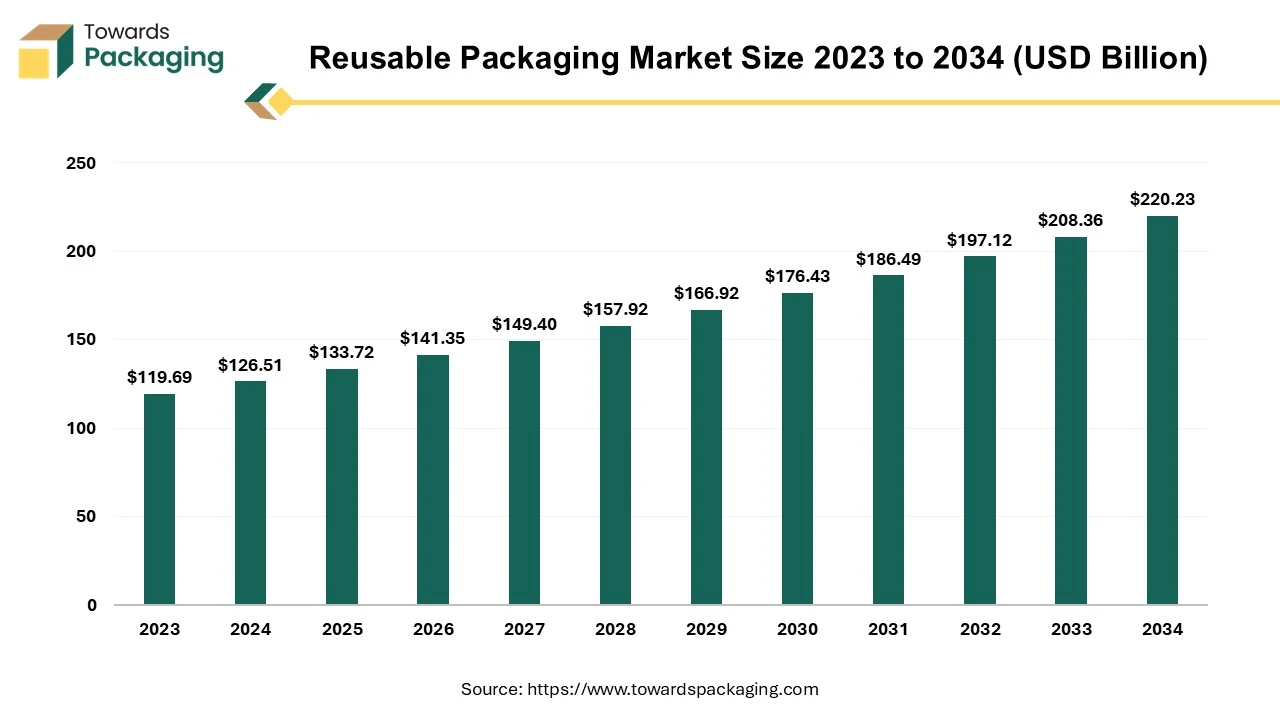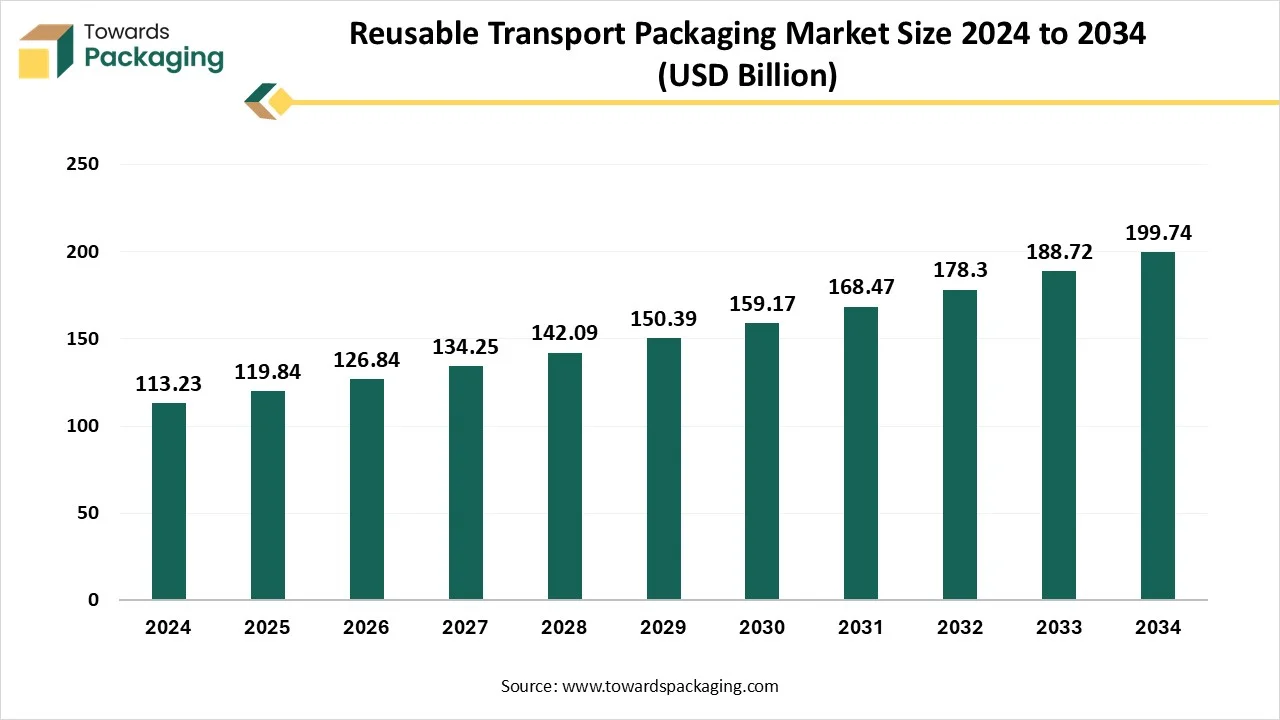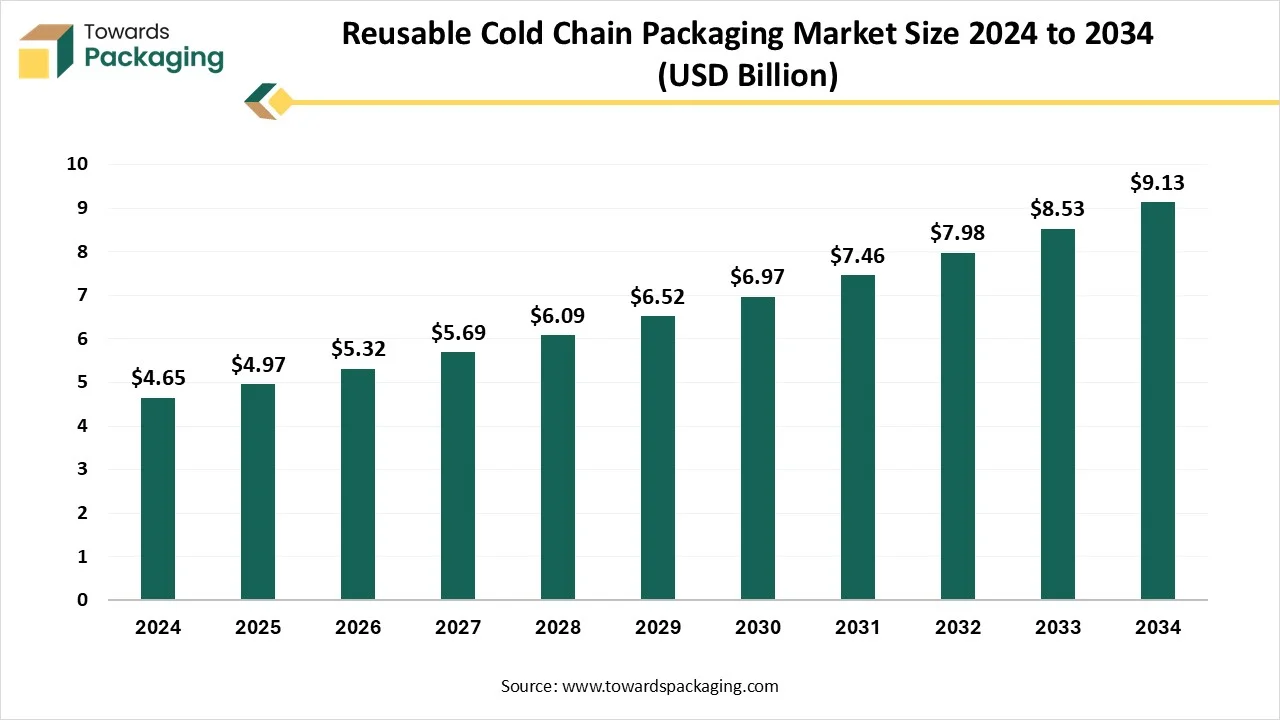Reusable Packaging Market Growth, Innovations and Market Size Forecast
The reusable packaging market is forecast to grow from USD 141.34 billion in 2026 to USD 232.78 billion by 2035, driven by a CAGR of 5.7% from 2026 to 2035. The market is being driven by a surge in e-commerce, urban delivery models, and growing demand for sustainable packaging. North America led the market in 2025, and Asia Pacific is expected to grow at a significant rate during the forecast period.
The plastic material segment held the largest market share in 2025, with containers being the dominant product type. The food & beverage sector remains the primary end-user of reusable packaging, reflecting a trend toward sustainability and circular economy models.

Major Key Insights of the Reusable Packaging Market
- North America dominated the reusable packaging market in 2024.
- Asia Pacific is expected to grow at a significant rate in the market during the forecast period.
- By material, the plastic segment dominated the market with the largest share in 2024.
- By product type, the containers segment registered its dominance over the global reusable packaging market in 2024.
- By end-use, the food & beverage segment dominated the reusable packaging market in 2024.
Reusable Packaging Market: Sustainable Packaging Type
In order to move goods through supply chains effectively and safely, reusable transport packaging typically consists of pallets, bins, tanks, intermediate bulk containers, reusable plastic containers, and other hand-held containers, as well as totes, trays, and dunnage. In order to assure their efficient recovery and return for ongoing usage, these packaging products are made to last. Transporting commodities, raw materials, ingredients, or parts to facilities for manufacturing or processing goods is a common usage. Next, completed goods are shipped to warehouses or distribution centers en route to commercial markets like wholesale or retail outlets. The majority of reusable transport packaging items are made for business-to-business use, but the rise of home delivery and e-commerce is creating new chances for reusable packing to be used effectively.
Key Metrics and Overview
| Metric |
Details |
| Market Size in 2025 |
USD 133.72 Billion |
| Projected Market Size in 2035 |
USD 232.78 Billion |
| CAGR (2025 - 2035) |
5.7% |
| Leading Region |
North America |
| Market Segmentation |
By Material, By Product Type, By End-Use and By Region |
| Top Key Players |
Smart Crates, Schoeller Arca Systems, Reusable Packaging Group, Polymer Logistics, Reusable Transit Packaging, Mauser Packaging Solutions, ORBIS Corp, Smurfit Kappa |
Market Trends
Expansion of Circular Economy Models
- The key players operating in the market are designing packaging not just to be reusable but to fit into closed-loop systems (e.g., clean, collect, refill, and reuse). Major retailers and FMCG brands are partnering with service providers to develop packaging return and reuse infrastructure.
Rise in Usage of Tech-Enabled Tracking
- The usage of QR codes, RFID tags, and IoT sensors to track packaging throughout its lifecycle. The smart tags help with return rates, logistics, and transparency for customers.
Return & Refill Stations Expansion
- Especially in cleaning products, beauty, and food service. Supermarkets, cafes, and even airports are adopting refill stations to support reusable packaging.
Premiumization of Reusable Packaging
- Brands are turning reusable packaging into a premium, aesthetic product. Focus on personalization, design, and material quality (glass, stainless steel, bamboo composites).
How Can AI Improve the Reusable Packaging Industry?
The packaging industry is only one of several that artificial intelligence (Al) is transforming. Al has evolved into a strategic pillar for reimagining packaging for the future in 2023, not just a technical instrument. Al is ushering in a new era of packaging through resource optimization, customisation, and environmental impact reduction. Al is a major contributor to the development of more ecologically friendly and sustainable packaging. Algorithms assist in determining the most environmentally friendly products and maximizing their utilization to cut down on waste. Al makes it possible to develop packaging that is lighter and less clunky without sacrificing product protection by examining real needs.
Driver
Expansion of Urban and E-commerce Delivery Models
Increase in e-commerce drives need for reusable, durable shipping containers. Last-mile delivery services in urban areas are adopting reusable systems for sustainability and branding. Growth in online shopping and expansion of E-commerce platforms has driven the growth of the reusable packaging market in near future. In January 2025, according to the data published by the National e-commerce associations, in 2024, the leaders in the e-commerce sector spent $3.5 billion on advertising overall, with individual expenditures ranging from US$41.3 million to US$1.7 billion. With a staggering US$1.7 billion, more than four times Walmart's expenditure, Amazon took the lead. In contrast, Aliexpress spent the least amount at US$322,000, which is 5,000 times less than Amazon. This is mostly because Aliexpress is utilized more frequently outside of the U.S. than it is in the U.S. Despite this low investment, Aliexpress.com's website traffic has increased significantly in the US.
Restraint
High Initial Investment Costs & Limited Infrastructure
The key players operating in the market are facing issue due to complex logistics & reverse supply chains, high initial investment costs and limited infrastructure, which has estimated to restrict the growth of the reusable packaging market in the near future. Upfront costs for durable materials, cleaning infrastructure, design, and tracking systems are significant. Many small and mid-sized businesses see this as a barrier compared to cheap single-use alternatives. Managing the cleaning, return, and redistribution of reusable packaging is complex. Inefficiencies in reverse logistics increase costs and carbon footprint if not optimized. In many regions, there is a lack of cleaning, repair, and storage facilities to support reusable systems. Lack of universal standards for packaging design complicates pooling and reusing across companies. Regulations on reuse systems vary widely across regions, causing complexity for multinational companies.
Market Opportunity
Growth of Circular Economy Models
Strong global momentum towards circular economy adoption. The key players operating in the market are redesigning supply chains around reuse, developing long-term opportunities for reusable packaging providers. Hence, the rise of circular economy models has estimated to create lucrative opportunity for the growth of the reusable packaging market in the near future. Development of lightweight, durable, and sustainable materials enhances packaging lifespan and appeal. Increasing launch of the design solutions for modularity, stackability, and aesthetics, has created lucrative opportunity for the growth of the reusable packaging market in the near future.
Segmental Insights
Plastic Segment Led the Market in 2024
The plastic segment held a dominant presence in the reusable packaging market in 2024. The plastic material is durable has longevity and withstand multiple use cycles. Resistant to impact, weather, moisture, and chemicals suitable for tough handling in logistics. Compared to metal or glass, plastic is much lighter, minimizing shipment cost and carbon footprint per shipment. Plastics can be easily molded into various shapes and sizes for different applications. Plastic packaging withstands harsh environments: UV exposure, moisture, chemicals, and temperature changes. Plastics integrate well with RFID tags, QR codes, and sensors for asset tracking and inventory management.
Containers Segment to Show Significant Share in Upcoming Years
The containers segment accounted for a considerable share of the reusable packaging market in 2024. As the reusable containers are reusable and lower long-term costs they are being sold more in number. The key players operating in the market are under pressure to meet zero-waste goals and carbon reduction targets. Reusable containers assist in reducing landfill waste and environmental impact. Reusable solutions are future-proof way to stay compliant. Reusable containers are stackable, nestable, and easy to handle, improving space utilization and reducing handling time. Strong materials mean reusable containers provide better protection against damage, minimizing losses and returns.
Expansion of Food & Beverage Industry, Supportive Factor to the Industry
The food & beverage segment registered its dominance over the global reusable packaging market in 2024. Food and beverage products move through supply chains rapidly and in large quantities, making reusable systems economically attractive. Frequent shipments mean more opportunities to reuse packaging efficiently. Reusable plastic crates, bins, and containers are easy to sanitize, clean, and sterilize, meeting strict food safety regulations. Reusable packaging solutions like crates and totes double as display units in retail (direct-to-shelf). Reusable packaging assists brands showcase their commitment to sustainability, especially in fresh produce and beverages. Major retailers (like Carrefour, Walmart, Tesco) prefer reusable packaging for faster restocking and reduced waste. As online grocery shopping expands, reusable packaging is ideal for last-mile delivery and return logistics. Shared pooling systems (like IFCO or CHEP) make reusable packaging more accessible to food producers without high upfront costs. Eco-conscious packaging becomes part of the brand story, especially for premium, organic, or ethical food brands.
Regional Insights
North America’s Expanding Food and Beverage Industry to Promote Dominance
North America region held the largest share of the reusable packaging market in 2024, owing to expansion of the food and beverages industry in the region. North America region has a highly developed logistics network (rail, air, road). Efficient supply chains in North America region benefits greatly from reusable packaging solutions like totes, pallets and crates for better inventory management and transportation. Major industries like food & beverage, automotive, pharmaceuticals and retail rely heavily on reusable packaging. Growing state-and federal-level regulations push companies to minimizes single-use plastics and embrace circular economy models. North American consumers are increasingly conscious of sustainability.
U.S. Reusable Packaging Market Trends
U.S. reusable packaging market is U.S. corporations are under growing pressure to meet environmental, governance (ESG) targets, and social targets. Initiatives such as the U.S. Plastics Pact and local zero-waste goals accelerate adoption. U.S. corporations are under growing pressure to meet Environmental, Social, and Governance (ESG) targets. The U.S. has a well-developed network of reusable packaging pool operators (e.g., CHEP USA, IFCO Systems, Tosca). Companies in the U.S. are heavily focused on operational efficiency and cost reduction. The U.S. has a vibrant ecosystem of startups innovating in reusable packaging systems.
Asia’s Cost Advantage in Production to Support the Growth
Asia Pacific region is anticipated to grow at the fastest rate in the reusable packaging market during the forecast period. Countries like China, India, Vietnam, and Indonesia are manufacturing powerhouses. Massive growth of online shopping in India (Flipkart, Amazon India), China (Alibaba, JD.com), and Southeast Asia. Asia Pacific has lower manufacturing costs for producing reusable packaging materials and components. Policies in countries like China (plastic ban & circular economy targets) and India (single-use plastic ban) strongly promote reusable packaging adoption. Regional frameworks like ASEAN sustainability initiatives also play a role. Asia Pacific is home to major automotive (China, Japan, South Korea) and electronics (China, Taiwan, South Korea) industries. Cities like Singapore, Shanghai, and Tokyo are piloting reusable packaging solutions in public and private sectors. Multinational corporations operating in Asia Pacific region (Unilever, Nestlé, Coca-Cola) are implementing global sustainability goals locally.
India Reusable Packaging Market Trends
India reusable packaging market is growing due to government pressure to reduce plastic usage. Nationwide ban on single-use plastics (phased out from 2022 onwards) is a big catalyst. The Swachh Bharat (Clean India) Mission promotes sustainable waste management. Shift towards Extended Producer Responsibility (EPR) regulations, making companies responsible for the lifecycle of packaging. Massive surge in e-commerce players like Amazon India, Flipkart, Reliance Retail. India is becoming a manufacturing hub for electronics, automobiles, and pharmaceuticals.
Europe’s Government Policies to Project Notable Growth
Europe region is seen to grow at a notable rate in the foreseeable future. European Green Deal and Circular Economy Action Plan aggressively promote reuse and recycling. Strict regulations on single-use plastics banned across EU since 2021. European consumers are highly eco-conscious and willing to pay a premium for sustainable packaging. Established companies like IFCO, CHEP Europe, Euro Pool System enable efficient pooling and circulation of reusable pallets, crates, and containers. Big European retailers (Tesco, Carrefour, Aldi) and food distributors utilize reusable packaging extensively. Many European countries offer financial incentives for businesses adopting reusable packaging systems.
Reusable Transport Packaging Market
The reusable transport packaging market is forecasted to expand from USD 119.84 billion in 2025 to USD 199.74 billion by 2034, growing at a CAGR of 5.84% from 2025 to 2034.This market is growing because the stringent government regulations worldwide, the challenge of global warming due to excessive CO2 emissions, single-use packaging waste management issues, and technological improvements in the packaging item return mechanism, all of which are driving the growth of the reusable packaging market. the market has huge potential in the upcoming times as environment-related awareness has increased throughout the world.

An increase in packaged food, e-commerce, retail shopping, and other packaging applications has surge in the use of single-use packaging, which is also generating an enormous amount of waste. Annually, 400 million tons of waste is generated due to the use of single-use plastic. This is creating a huge waste management challenge for the authorities, and an adverse impact on marine life due to improper waste management is becoming uncontrollable. The increasing CO2 emissions are leading to climate change and irregularities in monsoon, and the greenhouse effect has increased the temperature of the Earth.
Reusable E-Commerce Packaging Market
The global reusable e-commerce packaging market is forecast to grow at a CAGR of 9.54%, from USD 9.41 billion in 2025 to USD 21.12 billion by 2034, over the forecast period from 2025 to 2034. The key players operating in the market are focused on adopting inorganic growth strategies like acquisition and merger to develop advance technology for manufacturing sustainable packaging.
The market is growing rapidly, driven by greater environmental awareness, more stringent sustainability regulations, rising e-commerce sales, demand for less costly yet durable packaging, increased green material technology, green companies' popularity among consumers, and investments into returnable packaging and efficient reverse logistics systems, these can be considered the major growth propellers for the REPs market.

The reuse of packaging for online purchases is becoming more and more sought-after in the industry, with the specification that such packaging must be capable of repeated use. Unpacking spilling in the package, on the other hand, is rated an ecological nightmare for the carbon footprint. Environmental considerations are mounting, enforcement of stringent regulations is being imposed, and ESG commitments are being churned out.
Reusable Cold Chain Packaging Market
The global reusable cold chain packaging market is expected to grow from USD 4.97 billion in 2025 to USD 9.13 billion by 2034, with a CAGR of 6.98% throughout the forecast period from 2025 to 2034. The global reusable cold chain packaging market is driven by increasing sustainability demands, rising pharmaceutical and biologics shipments, and the growing need for reliable temperature-controlled logistics in food and beverage e-commerce.
Companies are adopting reusable solutions to reduce waste, cut long-term costs, and meet regulatory requirements, especially in healthcare. Technological advancements, such as IoT-enabled tracking, vacuum-insulated panels, and phase change materials, enhance performance and visibility. North America and Europe lead in adoption due to mature infrastructure, while Asia-Pacific is rapidly emerging. Despite challenges like high upfront costs and complex reverse logistics, the market offers strong growth potential through innovation and circular economy initiatives.

Reusable cold chain packaging refers to temperature-controlled packaging solutions that are specifically designed to be used multiple times for the safe transportation and storage of perishable or temperature-sensitive products such as pharmaceuticals, biologics, fresh food, dairy, and seafood. These packaging systems maintain a consistent internal temperature over a defined period by utilizing advanced insulation materials, such as phase change materials (PCMs), vacuum-insulated panels (VIPs), and gel packs.
Global Reusable Packaging Market Top Players

Latest Announcements by Reusable Packaging Industry Leaders
- At PACK EXPO 2024 in Chicago, ProAmpac, a world leader in flexible packaging and material science, will present its most recent packaging innovations. According to Hesam Tabatabaei, senior vice president of worldwide product development and innovation at ProAmpac, delivered more sustainable technologies in 2024 than ever before. The ProAmpac company’s new ProActive Intelligence M platform consists of smart and active packaging, while company enlarged ProActive Sustainability portfolio demonstrates company’s dedication to developing high-performance recyclable packaging. Without compromising functionality, these developments improve product protection and ease.
New Advancements in Reusable Packaging Industry
- On April 09, 2025, In 2025, International Paper acquired DS Smith, a well-known producer of fiber-based packaging, and introduced their 100% recyclable and reusable cooler as a sustainable substitute for Styrofoam and plastic coolers. With its eco-friendly, wax-free corrugated board construction, DS Smith's "GoChill Cooler" offers customers a way to keep food and drinks fresh while cutting down on waste and carbon emissions.
- In September 2024, ARRAY Technologies, a leader in utility-scale solar monitoring worldwide, revealed the launch of a novel reusable packaging solution that uses sturdy, reusable plastic casing in place of conventional cardboard boxes. This creative packaging is expected to greatly cut waste and support ARRAY's clients' sustainability objectives. Compared to conventional cardboard packing, the new reusable bulk packaging is made to be as efficient as possible, enabling the shipping of more tracker components per bulk.
Global Reusable Packaging Market Segments
By Material
- Plastic
- Wood
- Metal
- Glass
- Others
By Product Type
- Container
- Crates
- Bottles
- Pellets
- Drums & Barrels
- Others
By End-Use
- Food & Beverage
- Automotive
- Healthcare
- Logistics & Transportation
- Others
By Region
- North America
- Europe
- Germany
- UK
- France
- Italy
- Spain
- Sweden
- Denmark
- Norway
- Asia Pacific
- China
- Japan
- India
- South Korea
- Thailand
- Latin America
- Middle East and Africa (MEA)
- South Africa
- UAE
- Saudi Arabia
- Kuwait





